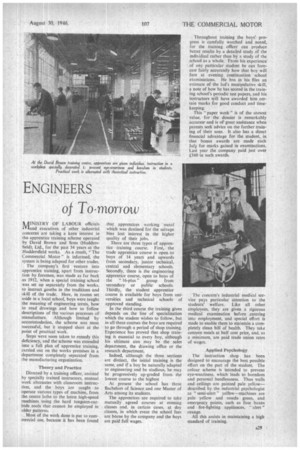ENGINEERS of To-morrow
Page 31

If you've noticed an error in this article please click here to report it so we can fix it.
IkAINISTRY OF LABOUR officials LViand executives of other industrial concerns are taking a keen interest in the. apprentice training scheme operated by David Brown and Sons (Huddersfield), Ltd., for the past 34 years at the Huddersfield works. As a result, "The Commercial Motor" is informed, the system is being adapted for other trades.
The company's first venture into apprentice training, apart from instruction by foremen, was made as far back as 1912, when a special training school was set up separately from the works, to instruct youths in the traditions and skill of the trade. Here, in rooms set aside in a local school, boys were taught the meaning of engineering terms, how to read drawings and how to follow descriptions .of the various processes of manufacture. Although limited by accommodation, the scheme was most successful, but it stopped short at the point of practical work.
Steps were soon taken to remedy this deficiency, and the scheme was extended into a full plan of apprentice training, carried out on the works premises in a department completely separated from the manufacturing organization.
Theory and Practice Directed by a training officer, assisted by specially trained instructors, manual work alternates with classroom instruction, and the boys are ' taught to operate various types of machine, from the centre lathe to the latest high-speed machines using the hard tungsten-carbide tools that cannot be employed in older patterns.
Most of the work done is put to commercial use, because it has been found that apprentices working metal which was destined for the salvage bins lost interest in the higher quality of their jobs.
There are three types of apprentice training course. First, the trade apprentice course is open. to boys of 14 years and upwards from secondary, junior technical, central and elementary schools. Secondly, there is the engineering apprentice course, open to boys of the " 16-plus" group from secondary or public schools. Thirdly, the student apprentice course is available for boys from universities and technical schools of approved standing.
In the third course the training given depends on the line of specialization which the student wishes to follow, but in all three courses the boys are required to go through a period of shop training. Experience has proved that shop training is essential to every boy, although his ultimate aim may be the sales department, the drawing office or the research department.
Indeed, although the three sections are distinct, the initial training is the same, and if a boy be naturally adapted to engineering and be studious, he may be progressively up-graded from. the lowest course to the highest
At present the school has three Bachelors of Science and one Master of Arts among its students.
The apprentices are required to take mutually agreed courses at evening classes and, in certain cases, at day classes, in which event the school fees are borne by the company and the boys are paid full wages. The concern's industrial medical service pays particular attention to the students' welfare. Like all other employees, they are given a rigorous medical examination before entering into employment, and special effort is made to enable them to maintain a completely clean bill of health. They take canteen meals at half cost price, and, as a minimum, are paid trade union rates of wages.
Applied Psychology The instruction shop has been designed to encourage the best possible effort on the part of the student. The colour scheme is intended to prevent eye-weariness, which leads to boredom and personal heedlessness. Thus walls and ceilings are painted pale yellow— described by the industrial psychologist as " semi-alert " yellow—machines are pale yellow and reseda green, and emergency. points, such as fuse boxes and fire-fighting appliances, " alert" orange.
All this assists in maintaining a high standard of training.




































































